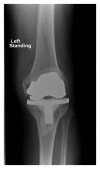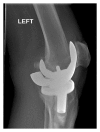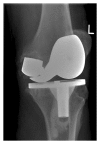Nontraumatic fracture of the femoral condylar prosthesis in a total knee arthroplasty leading to mechanical failure
- PMID: 24587928
- PMCID: PMC3920922
- DOI: 10.1155/2014/896348
Nontraumatic fracture of the femoral condylar prosthesis in a total knee arthroplasty leading to mechanical failure
Abstract
This paper reports a case of fatigue fracture of the femoral component in a cruciate-retaining cemented total knee arthroplasty (TKA). A 64-year-old man had undergone a primary TKA for osteoarthritis 10 years previously at another institution using the PFC-Sigma prosthesis. The patient recovered fully and was back to his regular activities. He presented with a history of sudden onset pain and locking of the left knee since the preceding three months. There was no history of trauma, and the patient was mobilizing with difficulty using crutches. Radiographs revealed fracture of the posterior condyle of the femoral prosthesis. Revision surgery was performed as an elective procedure revealing the broken prosthesis. The TC3RP-PFC revision prosthesis was used with a medial parapatellar approach. The patient recovered fully without any squeal. Mechanical failure of the knee arthroplasty prosthesis is rare, and nontraumatic fracture of the femoral metallic component has not been reported before.
Figures





Similar articles
-
Atraumatic Fracture of the Medial Femoral Condyle of a Total Knee Arthroplasty.Arthroplast Today. 2021 Apr 14;8:222-225. doi: 10.1016/j.artd.2021.03.006. eCollection 2021 Apr. Arthroplast Today. 2021. PMID: 33937462 Free PMC article.
-
Bilateral fatigue fracture of the femoral components in a cruciate-retaining cementless total knee prosthesis.Orthopedics. 2011 Oct 5;34(10):e688-91. doi: 10.3928/01477447-20110826-26. Orthopedics. 2011. PMID: 21956069
-
Intraoperative Femoral Condyle Fracture during Bone Preparation in a Cruciate-retaining Primary Total Knee Arthroplasty.J Orthop Case Rep. 2021 Feb;11(2):52-56. doi: 10.13107/jocr.2021.v11.i02.2024. J Orthop Case Rep. 2021. PMID: 34141671 Free PMC article.
-
Atraumatic Fracture of Cemented Vanguard Total Knee Arthroplasty Femoral Component.Orthopedics. 2020 Sep 1;43(5):e476-e479. doi: 10.3928/01477447-20200721-07. Epub 2020 Aug 6. Orthopedics. 2020. PMID: 32745220
-
Complications and failures of non-tumoral hinged total knee arthroplasty in primary and aseptic revision surgery: A review of 290 cases.Orthop Traumatol Surg Res. 2021 May;107(3):102875. doi: 10.1016/j.otsr.2021.102875. Epub 2021 Feb 27. Orthop Traumatol Surg Res. 2021. PMID: 33652151 Review.
Cited by
-
Revision for Solid-Body Breakage of the 3D-Printed Implant Following Joint-Sparing Surgery: A Technical Note.Orthop Surg. 2024 Apr;16(4):1010-1016. doi: 10.1111/os.13983. Epub 2024 Feb 5. Orthop Surg. 2024. PMID: 38316419 Free PMC article.
-
The incidence of implant fractures after knee arthroplasty.Knee Surg Sports Traumatol Arthrosc. 2016 Oct;24(10):3272-3279. doi: 10.1007/s00167-016-4160-8. Epub 2016 May 6. Knee Surg Sports Traumatol Arthrosc. 2016. PMID: 27154281 Review.
-
Bilateral Femoral Component Fractures After Primary Total Knee Arthroplasty With Cruciate-Retaining Femoral Component.Arthroplast Today. 2020 Jul 13;6(3):496-501. doi: 10.1016/j.artd.2020.06.001. eCollection 2020 Sep. Arthroplast Today. 2020. PMID: 32695866 Free PMC article.
-
Atraumatic Fracture of the Medial Femoral Condyle of a Total Knee Arthroplasty.Arthroplast Today. 2021 Apr 14;8:222-225. doi: 10.1016/j.artd.2021.03.006. eCollection 2021 Apr. Arthroplast Today. 2021. PMID: 33937462 Free PMC article.
References
-
- Lee C-S, Chen W-M, Kou H-C, Lo W-H, Chen C-L. Early nontraumatic fracture of the polyethylene tibial post in a NexGen LPS-Flex posterior stabilized knee prosthesis. Journal of Arthroplasty. 2009;24(8):1292.e5–1292.e9. - PubMed
-
- Clarke HD, Math KR, Scuderi GR. Polyethylene post failure in posterior stabilized total knee arthroplasty. Journal of Arthroplasty. 2004;19(5):652–657. - PubMed
-
- Bal BS, Greenberg D. Failure of a metal-reinforced tibial post in total knee arthroplasty. Journal of Arthroplasty. 2007;22(3):464–467. - PubMed
-
- Bal BS, Greenberg D, Li S, R. Mauerhan D, Schultz L, Cherry K. Tibial post failures in a condylar posterior cruciate substituting total knee arthroplasty. Journal of Arthroplasty. 2008;23(5):650–655. - PubMed
-
- Mauerhan DR. Fracture of the polyethylene tibial post in a posterior cruciate-substituting total knee arthroplasty mimicking patellar clunk syndrome a report of 5 cases. Journal of Arthroplasty. 2003;18(7):942–945. - PubMed
LinkOut - more resources
Full Text Sources
Other Literature Sources
Miscellaneous

